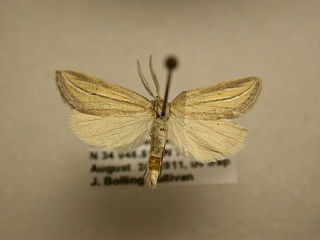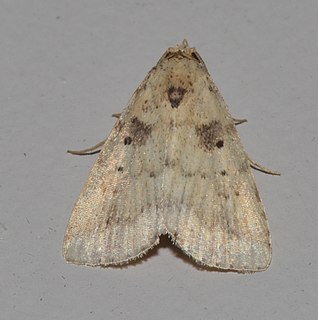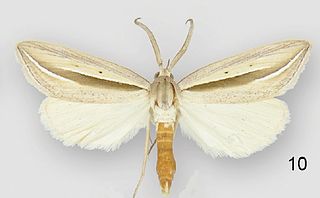
The Noctuidae, commonly known as owlet moths, cutworms or armyworms, are the most controversial family in the superfamily Noctuoidea because many of the clades are constantly changing, along with the other families of the Noctuoidea. It was considered the largest family in Lepidoptera for a long time, but after regrouping Lymantriinae, Catocalinae and Calpinae within the family Erebidae, the latter holds this title now. Currently, Noctuidae is the second largest family in Noctuoidea, with about 1,089 genera and 11,772 species. However, this classification is still contingent, as more changes continue to appear between Noctuidae and Erebidae.

Doryodes is a genus of moths in the family Erebidae.

Doryodes bistrialis, the double-lined doryodes moth, is a moth of the family Erebidae. The species was first described by Carl Geyer in 1832. It is found in the eastern United States, including Delaware, Virginia, Mississippi and Florida. Its habitat consists of wet pine flatwoods and pine savannas.

Amyna axis, the oriental eight-spot, is a moth of the family Noctuidae. The species was first described by Achille Guenée in 1852.

Argyrostrotis flavistriaria, the yellow-lined chocolate moth, is a moth of the family Noctuidae. The species was first described by Jacob Hübner in 1831. It is found in the US from North Carolina south to Florida and Texas.

Argyrostrotis sylvarum, the woodland chocolate moth or brown wavy line argyrostrotis, is a moth of the family Noctuidae. The species was first described by Achille Guenée in 1852. It is found in the US from Virginia south to Florida and Texas.

Argyrostrotis erasa, the erasa chocolate moth, is a moth of the family Noctuidae. The species was first described by Achille Guenée in 1852.) It is found in the US from North Carolina south to Florida and Texas.

Argyrostrotis deleta is a moth of the family Noctuidae first described by Achille Guenée in 1852. It is found in the United States from Virginia south to Florida and Texas.

Argyrostrotis quadrifilaris, the four-lined chocolate moth, is a moth of the family Noctuidae. The species was first described by Jacob Hübner in 1831. It is found in the US from New York and New Hampshire south to Florida and Texas.
Apantesis placentia, the placentia tiger moth, is a moth of the family Erebidae. It was described by James Edward Smith in 1797. It is found in the south-eastern United States, from New Jersey to Florida. The habitat consists of dry, sandy open wooded areas, primarily pine barrens.

Arugisa lutea, the common arugisa moth, is a species of moth in the family Erebidae. The species was first described by John B. Smith in 1900. It is found in the United States, where it has been recorded from Maryland and Virginia to Florida, west to Texas and Missouri.
The Euclidiini are a tribe of moths in the family Erebidae. The tribe was erected by Achille Guenée in 1852.

Doryodes insularia is a moth of the family Erebidae first described by George Hampson in 1904. It is found on the Bahamas.

Doryodes spadaria, the dull doryodes moth, is a moth of the family Erebidae. The species was first described by Achille Guenée in 1857. It is found in North America, where it has been recorded from coastal Florida, Georgia, North Carolina, South Carolina and Texas. The habitat consists of salt marshes.

Doryodes desoto is a moth of the family Erebidae first described by J. Donald Lafontaine and James Bolling Sullivan in 2015. It is found along the Gulf Coast of the US state of Florida between Sarasota County and Gulf County. The habitat consists of coastal salt marshes.

Doryodes fusselli is a moth of the family Erebidae first described by J. Donald Lafontaine and James Bolling Sullivan in 2015. It is found in the US state of North Carolina, occurring from Dare County in the north to Brunswick and New Hanover counties in the south.

Doryodes latistriga is a moth of the family Erebidae first described by J. Donald Lafontaine and James Bolling Sullivan in 2015. It is found in the United States in tidal creeks and salt marshes from Alabama to Louisiana.

Doryodes broui is a moth of the family Erebidae first described by J. Donald Lafontaine and James Bolling Sullivan in 2015. It is found in the United States from Alabama to southern Texas.

Doryodes reineckei is a moth of the family Erebidae first described by J. Donald Lafontaine and James Bolling Sullivan in 2015. It is found along the US Gulf Coast in the western panhandle of Florida along to eastern Texas. The habitat consists of Spartina marshes.

Selenisa sueroides, the pale-edged selenisa or legume caterpillar, is an owlet moth in the family Erebidae. The species was first described by Achille Guenée in 1852. It is found in North America.















